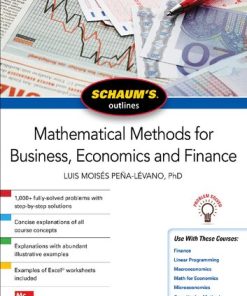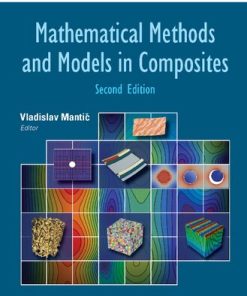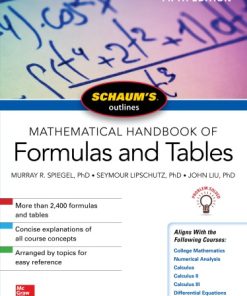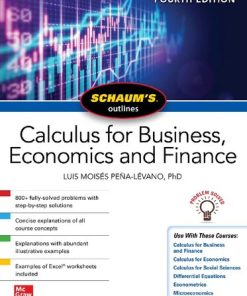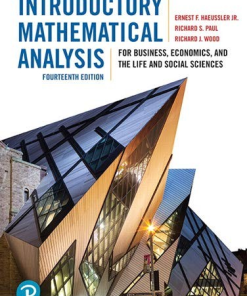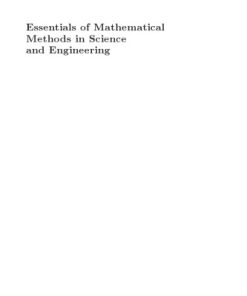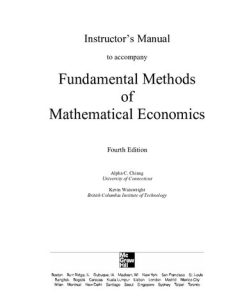(Ebook PDF) Schaums Outline of Mathematical Methods for Business Economics and Finance 2nd Edition by Luis Moises Pena Levano 126426688X 9781264266883 full chapters
$50.00 Original price was: $50.00.$25.00Current price is: $25.00.
Schaum’s Outline of Mathematical Methods for Business, Economics and Finance 2nd Edition by Luis Moises Pena-Levano – Ebook PDF Instant Download/DeliveryISBN: 126426688X, 9781264266883
Full dowload Schaum’s Outline of Mathematical Methods for Business, Economics and Finance 2nd edition after payment.
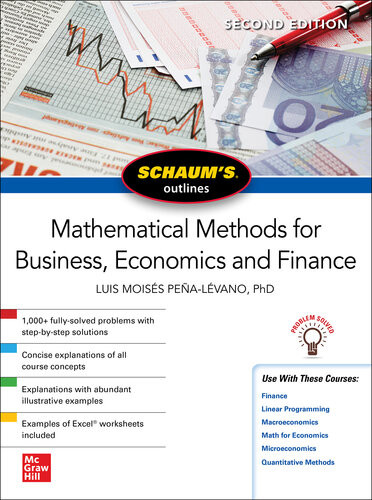
Product details:
ISBN-10 : 126426688X
ISBN-13 : 9781264266883
Author: Luis Moises Pena-Levano
The most useful tool for reviewing mathematical methods for business and economics classes—now with more content Schaum’s Outline of Mathematical Methods for Business, Economics and Finance, Second Edition is the go-to study guide for students enrolled in business and economics courses that require a variety of mathematical skills. No mathematical proficiency beyond the high school level is assumed, enabling students to progress at their own rate and adapt the book to their own needs. With an outline format that facilitates quick and easy review, this guide helps you understand basic concepts and get the extra practice you need to excel in business and economics courses. Schaum’s Outline of Mathematical Methods for Business, Economics and Finance, Second Edition supports the bestselling textbooks and is ideal study aid for classes such as Calculus for Business, Applied Calculus, Calculus for Social Sciences and Calculus for Economics. Chapters include Equations and Graphs, Functions, Systems of Equations, Linear (or Matrix) Algebra, Linear Programming, Differential Calculus, Exponential and Logarithmic Functions, Integral Calculus, Calculus of Multivariable Functions, and more.
Schaum’s Outline of Mathematical Methods for Business, Economics and Finance 2nd Table of contents:
Chapter 1 Review
1.1 Exponents
1.2 Polynomials
1.3 Factoring
1.4 Fractions
1.5 Radicals
1.6 Order of Mathematical Operations
1.7 Use of a Pocket Calcular
Chapter 2 Equations and Graphs
2.1 Equations
2.2 Cartesian Coordinate System
2.3 Linear Equations and Graphs
2.4 Slopes
2.5 Intercepts
2.6 The Slope-Intercept Form
2.7 Determining the Equation of a Straight-Line
2.8 Applications of Linear Equations in Business and Economics
Chapter 3 Functions
3.1 Concepts and Definitions
3.2 Graphing Functions
3.3 The Algebra of Functions
3.4 Applications of Linear Functions for Business and Economics
3.5 Solving Quardratic Equations
3.6 Facilitating Nonlinear Graphing
3.7 Applications of Nonlinear Functions in Business and Economics
Chapter 4 System of Equations
4.1 Introduction
4.2 Graphical Solutions
4.3 Supply-and-Demand Analysis
4.4 Break-Even Analysis
4.5 Elimination and Substitution Methods
4.6 Income Determination Models
4.7 IS-LM Analysis
4.8 Economic and Mathematical Modeling (Optional)
4.9 Implicit Functions and Inverse Functions (Optional)
Chapter 5 Linear (or Matrix) Algebra
5.1 Introduction
5.2 Definitions and Terms
5.3 Addition and Subtraction of Matrices
5.4 Scalar Multiplication
5.5 Vector Multiplication
5.6 Multiplication of Matrices
5.7 Matrix Expression of a System of Linear Equations
5.8 Augmented Matrix
5.9 Row Operations
5.10 Gaussian Method of Solving Linear Equations
Chapter 6 Solving Linear Equations with Matrix Algebra
6.1 Determinants and Linear Independence
6.2 Third-Order Determinants
6.3 Cramer’s Rule for Solving Linear Equations
6.4 Inverse Matrices
6.5 Gaussian Method of Finding an Inverse Matrix
6.6 Solving Linear Equations with an Inverse Matrix
6.7 Business and Economic Applications
6.8 Special Determinants
Chapter 7 Linear Programming: Using Graphs
7.1 Use of Graphs
7.2 Maximization Using Graphs
7.3 The Extreme-Point Theorem
7.4 Minimization Using Graphs
7.5 Slack and Surplus Variables
7.6 The Basis Theorem
Chapter 8 Linear Programming: The Simplex Algorithm and the Dual
8.1 The Simplex Algorithm
8.2 Maximization
8.3 Marginal Value or Shadow Pricing
8.4 Minimization
8.5 The Dual
8.6 Rules of Transformation to Obtain the Dual
8.7 The Dual Theorems
8.8 Shadow Prices in the Dual
8.9 Integer Programming .
8.10 Zero-One Programming
Chapter 9 Differential Calculus: The Derivative and the Rules of Differentiation
9.1 Limits
9.2 Continuity
9.3 The Slope of a Curvilinear Function
9.4 The Derivative
9.5 Differentiability and Continuity
9.6 Derivative Notation
9.7 Rules of Differentiation
9.8 Higher-Order Derivatives
9.9 Implicit Functions
Chapter 10 Differential Calculus: Uses of the Derivative
10.1 Increasing and Decreasing Functions
10.2 Concavity and Convexity
10.3 Relative Extrema
10.4 Inflection Points
10.5 Curve Sketching
10.6 Optimization of Functions
10.7 The Successive-Derivative Test
10.8 Marginal Concepts in Economics
10.9 Optimizing Economic Functions for Business
10.10 Relationships Among Total, Marginal, and Average Functions
Chapter 11 Exponential and Logarithmic Functions
11.1 Exponential Functions
11.2 Logarithmic Functions
11.3 Properties of Exponents and Logarithms
11.4 Natural Exponential and Logarithmic Functions
11.5 Solving Natural Exponential and Logarithmic Functions
11.6 Logarithmic Transformation of Nonlinear Functions
11.7 Derivatives of Natural Exponential and Logarithmic Functions
11.8 Interest Compounding
11.9 Estimating Growth Rates from Data Points
Chapter 12 Integral Calculus
12.1 Integration
12.2 Rules for Indefinite Integrals
12.3 Area Under a Curve
12.4 The Definite Integral
12.5 The Fundamental Theorem of Calculus
12.6 Properties of Definite Integrals
12.7 Area Between Curves
12.8 Integration by Substitution
12.9 Integration by Parts
12.10 Present Value of a Cash Flow
12.11 Consumers’ and Producers’ Surplus
Chapter 13 Calculus of Multivariable Functions
13.1 Functions of Several Independent Variables
13.2 Partial Derivatives
13.3 Rules of Partial Differentiation
13.4 Second-Order Partial Derivatives
13.5 Optimization of Multivariable Functions
13.6 Constrained Optimization with Lagrange Multipliers
13.7 Income Determination Multipliers
13.8 Optimizing Multivariable Functions in Business and Economics
13.9 Constrained Optimization of Multivariable Economic Functions
13.10 Constrained Optimization of Cobb-Douglas Production Functions
13.11 Implicit and Inverse Function Rules (Optional)
Chapter 14 Sequences and Series
14.1 Sequences
14.2 Representation of Elements
14.3 Series and Summations
14.4 Property of Summations
14.5 Special Formulas of Summations
14.6 Economics Applications: Mean and Variance
14.7 Infinite Series
14.8 Finance Applications: Net Present Value
People also search for Schaum’s Outline of Mathematical Methods for Business, Economics and Finance 2nd:
schaum’s outline of introduction to mathematical economics
schaum’s outline of mathematical methods for business and economics
schaum’s outline of mathematical methods for business and economics pdf
schaum’s outline series mathematical handbook of formulas and tables pdf
schaum’s outline of mathematical methods for business and economics
You may also like…
Politics & Philosophy - Social Sciences
Business & Economics - Investing
(EBOOK PDF)Hedge Funds For Dummies 2nd edition by Ann Logue 1119907551 9781119907558 full chapters
Mathematics - Mathematical Theory
Mathematical Methods and Models in Composites 2nd Edition Manti´`
Mathematics
Schaum’s Outline of Calculus for Business, Economics and Finance, Fourth Edition (Schaum’s Outlines)
Education Studies & Teaching - School Education & Teaching
Introductory Mathematical Analysis for Business, Economics, and the Life and Social Sciences
Mathematics - Mathematical Physics
Essentials of Mathematical Methods in Science and Engineering 2nd Edition S. Selcuk Bayin
Business & Economics - Mathematical Economics
Instructor’s Manual for Fundamental Methods of Mathematical Economics 4th Edition Alpha C. Chiang






